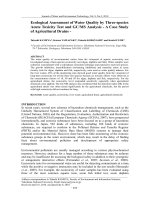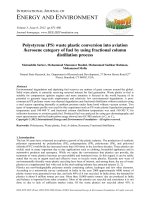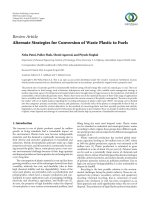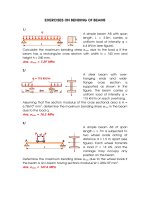PLASTIC BENDING OF MS BEAMS
Bạn đang xem bản rút gọn của tài liệu. Xem và tải ngay bản đầy đủ của tài liệu tại đây (468.13 KB, 17 trang )
15
Plastic bending of mild-steel beams
15.1
Introduction
We have seen that in the bending of a beam the greatest direct stresses occur in the extreme
longitudinal fibres; when these stresses attain the yield-point values, or exceed the limit of
proportionality, the distribution of stresses over the depth of the beams
no
longer remains linear,
as in the case of elastic bending.
The general problem of the plastic bending of beams is complicated; plastic bending of a beam
is governed by the forms of the stress-strain curves of the material in tension and compression.
Mild steel, which is used extensively as a structural material, has tensile and compressive
properties which lend themselves to a relatively simple treatment of the plastic bending of beams
of this material. The tensile and compressive stress-strain curves for an annealed mild steel have
the forms
shown
in Figure
15.1;
in the elastic range Young's modulus is the same for tension and
compression, and of the order of 300 MNIm2. The yield point corresponds to a strain of the order
0.001
5.
When the strain corresponding with the upper yield point is exceeded straining takes place
continuously at a constant lower yield stress until a strain of about
0.015
is attained; at this stage
further straining is accompanied by an increase in stress, and the material is said to
strain-harden.
This region of strain-hardening begins at strains about ten times larger than the strains at the yield
point of the material.
Figure
15.1
Tensile and compressive stress-strain curves of
an
annealed mild
steel.
In applying these stress-strain curves to the plastic bending of mild-steel beams we simplify the
problem by ignoring the upper yield point of the material; we assume the material is elastic, with
a Young's modulus
E,
up to a yield stress
0,;
Figure
15.2.
We assume that the yield stress,
cy,
and
Young's modulus,
E,
are the same for tension and compression. These idealised stress-strain
curves for tension and compression are then similar in form.
Beam
of
rectangular cross-section
35
1
Figure
15.2
Idealized tensile and compressive stress-strain curves
of
annealed
mild
steel.
15.2 Beam
of
rectangular cross-section
As
an example
of
the application of these idealised stress-strain curves for mild steel, consider the
uniform bending of a beam of rectangular cross-section;
b
is the breadth
of
the cross-section and
h
its depth, Figure 15.3(i). Equal and opposite moments Mare applied to the ends
of
a length of
the beam. We found that in the elastic bending of a rectangular beam there is a linear distribution
of direct stresses over a cross-section
of
the beam; an axis at the mid-depth
of
the cross-section is
unstrained and therefore a neutral axis. The stresses are greatest in the extreme fibres
of
the beam;
the yield stress,
oy,
is attained in the extreme fibres, Figure 15.3(ii), when
20,I
M=
-
My
(say)
h
where
I
is the second moment
of
area of the cross-section about the axis of bending. But
I
=
bh3/12,
and
so
1
6
My
=
-bh20y
(15.1)
As
the beam is bent beyond
this
initial yielding condition, experiment shows that plane cross-
sections
of
the beam remain nearly plane as in the case
of
elastic bending. The centroidal axis
remains a neutral axis during inelastic bending, and the greatest strains occur in the extreme tension
and compression fibres. But the stresses in these extreme fibres cannot exceed
oy,
the yield stress;
at an intermediate stage in the bending
of
the beam the central core is still elastic, but the extreme
fibres have yielded and become plastic, Figure 15.3(iii).
352
Plastic
bending
of mild-steel
beams
Figure
15.3 Stages
in
the elastic and plastic bending
of
a
rectangular mild-steel beam.
If the curvature
of the beam is increased the elastic core is diminished in depth; finally a
condition is reached where the elastic core is reduced to negligible proportions, and the beam is
more or less wholly plastic, Figure 15.3(iv); in
this
final condition there is still a central unstrained,
or neutral,
axis;
fibres above the neutral
axis
are stressed to the yield point in tension, whereas
fibres below the neutral
axis
to the yield point are in compression.
In
the ultimate fully plastic
condition the resultant longitudmal tension in the upper half-depth of the beam is
1
-
bho,
2
There is an equal resultant compression in the lower half-depth. There is, therefore,
no
resultant
longitudinal thrust in the beam; the bendmg moment for
this
fully plastic condition is
(15.2)
Mp
=
(;bho,)(fh)
=
-bh20,
1
4
This
ultimate moment is usually called thefirllyplastic
moment
of the beam; comparing equations
(15.1) and (15.2) we get
(15.3)
3
Mp
=
TMy
Thus
plastic collapse of a rectangular beam occurs at a moment
50%
greater than the bending
moment at initial yielding of the beam.
15.3
Elastic-plastic bending
of
a rectangular mild-steel beam
In
section 15.2 we introduced the concept of a fully plastic moment,
Mm
of a rmld-steel beam;
this
moment is attained when all longitudinal fibres
of
the beam are stressed into the plastic range of
the material. Between the stage at which the yield stress is first exceeded and the ultimate stage
at which the fully plastic moment is attained, some fibres at the centre of the beam are elastic and
those remote from the centre are plastic. At
an
intermediate stage the bending is elastic-plastic.
Elastic-plastic bending
of
a rectangular mild-steel beam
353
Figure
15.4
Elastic-plastic bending
of
a rectangular section beam.
Consider again a mild-steel beam
of
rectangular cross-section, Figure
15.4,
which is bent about
the centroidal axis
Cx.
In
the elastic-plastic range, a central region
of
depth
h,
remains elastic;
the yield stress a,is attained in fibres beyond
hs
central elastic core.
If
the central region
of
depth
h,
behaves as
an
elastic beam, the radu
of
curvature,
R,
is given by
E
(15.4)
20,
-
h0
R
where
E
is Young's modulus in the elastic range
of
the material. Then
LKO,
h,
=
-
(15.5)
E
Now, the bending moment carried by the elastic cor:
of
the beam is
bhi
6
M,
=
Or
-
(15.6)
and the moment due
to
the stresses in the extreme plastic regions is
M2
=
[$
-
$1
(15.7)
The total moment is, therefore,
M
=
M,
+
M,
=
0~4
bh
'
+
Oy
[b:
-
-
$1
354
Plastic bending
of
mild-steel beams
whch gives
(15.8)
But the fully plastic moment,
Mp,
of the beam is
Thus equation
(15.8)
may be written
M
=
Mpl
I
:;I
On substituting for
h,
from equation
(15.5),
At the onset of plasticity in the beam,
h
-
'OY
-
(i)
(say)
Y
R
E
Then equation
(
15.10)
may be written
1
(hlR):
Mf
3
(hlR)'
M-
1
(15.9)
(15.10)
(15.11)
(15.12)
Values of
(M/Mp)
for different values of
(h/R)/(h/R),
are given in Figure
15.5;
the elastic limit of
the beam is reached when
2
3
M
=
-Mp
=
MY
(say)
As
M
is increased beyond
My,
the fully plastic moment
Mp
is approached rapidly with increase of
curvature
(I&)
of the beam;
M
is greater than
99%
of
the fully plastic moment when the curvature
is only five times as large as the curvature at the onset of plasticity.
Fully plastic moment of an I-section; shape factor
355
Figure 15.5
Moment-curvature relation
for
the elastic-plastic
bending
of
a rectangular mild-steel beam.
15.4
Fully
plastic moment of an I-section; shape factor
The cross-sectional dimensions of
an
I-section are
shown
in Figure
15.6;
in the fully plastic
condition, the centroidal axis
Cx
is a neutral axis of bending. The tensile fibres of the beam all
carry the same stress
or;
the total longitudinal force in the upper flange is
Grbt/
and its moment about
Cx
is
orb{
3h
-
+/)
=
Za,btf
1
(h
-
t,)
Similarly, the total force in the tensile side of the web is
or(;
-
t/)
tw
and its moment about
Cx
is
1
'
(i
)*
8
70'
-h
-
tf
t,,,
=
-ort,,(h
-
2tJ'
The compressed longitudinal fibres contribute moments of the same magnitudes. The total
moment carried by the beam is therefore
356
Plastic bending
of
mild-steel beams
(15.13)
I
1
M,,
=
o,bgh
-
t,)
+
-tw
(h
-
2fx
[
4
Figure 15.6
Fully
plastic moment
of
an
I-section beam.
In
the case
of
elastic bending we defined the elastic section modulus,
Z,,
as
a geometrical
property, which, when multiplied by the allowable bending stress, gives the allowable bending
moment
on
the beam.
In
equation
(
15.13) suppose
(15.14)
1
4
Z,
=
b$(h
-
t,)
+
-tw
(h
-
2'1
Then
Z,
is the
plastic
section
modulus
of
the I-beam, and
Mp
=
oyzp
(15.15)
As
a particular case consider
an
I-section having dimensions:
h
=
20cm,
b
=
lOcm,
t,
=
0.70cm
fr
=
1.00cm
Then
1
4
Z,,
=
(0.1)(0.010)(0.2
-
0.010)
+
-(0.007)(0.2
-
0.020)2
=
0.247
x
lO-3
m3
The elastic section modulus is approximately
Z,
=
0.225
x
lO-3
m3
If
M,
is
the bending moment at which the yield stress
o,
is first reached in the extreme fibres
of
the
beam, then
More general case
of
plastic bending
357
zp
0247
(15.16)
-
-
1.10
MP
My Z,
0225
Thus, in
this
case,
the
fully plastic moment is only 10% greater than the moment at initial yielding.
The ratio
(Z&J
is sometimes called the
shapefactor.
15.5
More general case
of
plastic bending
In
the case of the rectangular and I-section beams treated
so
far, the neutral axis of bending
coincided with an
axis
of symmetry of the cross-section. For a section that is unsymmetrical about
the axis of bending, the position of the neutral axis must be found first. The beam in Figure 15.7
has one axis of symmetry,
Oy;
the beam is bent into the fully plastic condition about
Ox,
whch is
perpendicular to
Oy.
The axis
Ox
is the neutral axis of bending; the total longitudinal force on the
fibres above
Ox
is
Ala,
where
A,
is the area of the cross-section of the beam above
Ox.
If
A2
is
the area of the cross-section below
Ox,
the total longitudinal force
on
the fibres below
Ox
is
ApU
If there is
no
resultant longitudinal thrust in the beam, then
A0
=Ao
1Y
2Y
that is,
A,
=
A,
(15.17)
Figure
15.7
Plastic bending
of
a beam having
one
axis
of
symmetry
in
the
cross-section,
but
unsymmetrical about the
axis
of
bending.
The neutral axis
Ox
divides the beam cross-section into equal areas, therefore. If the total area
of cross-section is
A,
then
1
1
22
A =A
=-A
358
Then
Plastic bending
of
mild-steel beams
1
2
A,o,
=
A,o,
=
-Ao,
Suppose
C,
is the centroid of the area
A,
and
C,
the centroid of
A,;
if the centroids
C,
and
C,
are
distances
F,
and
y2,
respectively, from the neutral axis
Ox,
then
(15.18)
1
Mp
=
,A.,(Y,
+E)
The plastic section modulus is
(15.19)
MP
I
0,
2
Z,,
=
-
=
-A(
y,
+
y,
)
Problem
15.1
A
10
cm by
10
cm T-section is of uniform thickness
1.25
cm. Estimate the
plastic section modulus for bending about an axis perpendicular
to
the
web.
Solution
The neutral axis of plastic bending divides the section into equal areas. If the neutral axis is a
distance
h
below the extreme edge of the flange,
(O.l)h
=
(0.0875)(0.0125)
+
(0.1)(0.0125
-
h)
Then
h
=
0.0117
m
Then
Comparison
of
elastic and plastic section moduli
359
Mp
=
-(0.1)(0.0117)'oy
1
+
-(0.0875)(0.0008)'oy
1
2
2
1
2
+
-(0.0883)2(0.0 1230,
=
(0.0557
x
10-3)o,
The plastic section modulus is then
The elastic section modulus is
Ze
=
0.0311
x
m3
Then
15.6
Comparison
of
elastic and plastic section moduli
For bending
of
a beam about a centroidal axis
Cx,
the elastic section modulus is
I
z,
=
-
Y,,
(15.20)
where
I
is the second moment
of
area
of
the cross-section about the axis of bending, andy,, is the
distance
of
the extreme fibre from the axis
of
bending.
From equation (15.19) the plastic section modulus of a beam is
1-
-
A
ZP
=
-(
Y,
+
Y2
)
(15.21)
Values
of
Z,
and Z, for some simple cross-sectional forms are shown in Table 15.1.
In
the solid
rectangular and circular sections
Z,,
is considerably greater than
Z,;
the difference between
Z,,
and
Z,
is less marked in the case
of
thin-walled sections.
360
Plastic
bending
of
mild-steel beams
Table
15.1
Comparison
of
elastic
and
plastic section moduli
for
some simple cross-sectional
forms
Regions
of
plasticity in
a
simply-supported beam
361
15.7
Regions
of
plasticity in a simply-supported beam
The mild-steel beam shown in Figure 15.8
has
a rectangular cross-section; it is simply-supported
at each end, and carries a central lateral load
W.
The variation of bendmg moment has the form
shown in Figure
15.8@);
the greatest bending moment occurs under the central load and has the
value
W4.
From the preceding analysis we see that a section may take an increasing bending
moment until the fully plastic moment
Mp
of the section is reached. The ultimate strength
of
the
beam is reached therefore when
(15.22)
WL
4
Mp
=
-
Figure
15.8
Plastic
bending
of
a
simply-supported beam.
If
b
is the breadth and
h
the depth of the rectangular cross-section, the bending moment,
My,
at which the yield stress,
or,
is frrst attained in the extreme fibres is
My
=
Oy-
6
-
TM'
bh2
-
2
At the ultimate strength of the beam
(15.23)
w
=
-
44
- -
#iyT]
bh
2
L
The beam is wholly elastic for a distance
of
(15.24)
2(L)
=
-L
1
32
3
from each end support, Figure
15.9,
as the bending moments in these regions are not greater than
My.
The middle-hrd length
of
the beam is in an elastic-plastic state; in
this
central region
consider a transverse section
a-a
of the beam, a distance
z
from the mid-length. The bending
3
62
moment at this section
is
Plastic bending
of
mild-steel beams
M
=
&(fL
-2)
(15.25)
2
If
Whas
attained
its
ultimate value given
by
equation (15.22),
M
=
ZMp(tL-2) L
(15.26)
Suppose the depth
of
the elastic core of the beam at
this
section is
h,
Figure 15.9; then from
equation (15.9),
M
=
Mp
1
[
:;I
Figure
15.9
Regions
of
plasticity
in
a simply-supported beam carrying a
distributed
load;
in
the figure the depth
of
the
beam
is exaggerated.
On substituting
this value of
M
into equation (15.26), we have
I
h,Z
=
I
22
(15.27)
3h’
L
and thus
(15.28)
6h’
z
h,Z
=
-
L
Regions
of
plasticity in a simply-supported beam
363
The total depth
h,
of the elastic core varies parabolically with
z,
therefore; from equation (1
5.28),
h,
=
h
when
z
=
1/6L.
The regions of full plasticity are wedge-shaped; the shapes of the regions
developed
in
an actual mild-steel beam may be affected by, first, the stress-concentrations under
the central load
W,
and, second, the presence of shearing stresses on sections such as
a-a,
Figure
15.9; equation
(15.28)
is
true strictly for conditions of pure bending only.
For a simply-supported rectangular beam carrying a total uniformly distributed load
W,
Figure
15.10, the bending moment at the mid-length is
WL
8
M,
=
-
at the ultimate load-carrying capacity of the beam. At a transverse section
a-a,
a distance
z
from
the mid-length, the moment is
M
=
“(L’
8L
-
4z2)
=
F
(L2
-
4z2)
=
Mp[l-4(:)2]
(15.29)
Figure
15.10
Regions
of
plasticity
in
a simply-supported beam carrying a
distributed load; in the figure the depth
of
the beam
is
exaggerated.
From equation (15.9), the depth
h,
of the elastic core at the section
a-a
is given by
M
=
Mp
1
[
:j
Then
hi
=
12h2
(;)*
or
364
Plastic
bending
of
mild-steel beams
h,
=
2&
h(:)
(15.30)
The limit of the wholly elastic length of the beam
is
given by
h
=
h,
or z
=
W(2
4).
The regions
of plasticity near the mid-section are triangular-shaped, Figure 15.10.
15.8
Plastic collapse
of
a built-in beam
A
uniform
beam of length L is built-in at each end to rigid walls, and carries a
uniformly
distributed load w per
unit
length, Figure 15.1
1.
If
the material remains elastic, the bending
moment at each end
is
wL2/12, and at the mid-length wL2/24. The bending moment is therefore
greatest at the end supports; if yielding occurs first at a bending moment
My,
then the lateral load
at
this
stage is given by
WL
2
My
=
-
12
(15.31)
Figure
15.11
Plastic
regions
of
a
uniformly
loaded
built-in beam.
or
124
WL
=
-
(15.32)
L
Plastic collapse
of
a
built-in beam
365
If the load
w
is increased beyond the limit of elasticity, plastic hinges first develop at the remote
ends. The beam only becomes a mechanism when a hrd plastic hinge develops at the mid-length.
On
considering the statical equilibrium of
a
half-span of the beam we find that the moments at the
ends and the mid-length, for plastic hinges at these sections,
are
(15.33)
WL
2
MI.
=
-
16
or
16M,
L
WL
=
-
(15.34)
Clearly, the load causing complete collapse is at least one-third greater than that at which initial
yielding begins because
Mp
is greater than
My.
Another method ofplastically analysing the beam of Figure
15.1 1
is by the
principle
of
virtual
work
described in Chapter
17.
In
this
case the beam is assumed to collapse in the form of a
mechanism, when three plastic hmges form, as shown in Figure
15.12.
As the beam is encastrk at both ends, it is statically indeterminate to the
second degree,
therefore
three hinges
are required to change it from a beam structure to a mechanism.
Figure
15.12
Plastic
collapse
of
a
beam.
Thus, because the beam cannot resist further loading at the three hinges, the slightest increase
in load causes the hinges to rotate like 'rusty' hinges. Additionally, as the bending moment
mstribution is constant during
this
collapse, the curvature
of
the beam remains constant during
collapse. Hence, for the purpose of analysis, the beam's
two
sections can be assumed to remain
straight during collapse.
Work done by
the
three hinges during collapse
=
MpO
+
Mp
20
+
MpO
(15.35)
366
Plastic bending
of
mild-steel beams
Work done by the distributed load
L
4
WL
x
-e
Equating (15.35) and (15.36)
WL WL
4
16
4Mp8
=
-8
or
Mp
=
-
(15.36)
(15.37)
which is identical to equation (15.33). This method of solution is discussed in greater detail in
Chapter 17.
Further
problems
(answers
on
page
693)
15.2
15.3
15.4
15.5
15.6
15.7
A
uniform mild-steel beam
AB
is
4
m long; it is built-in at
A
and simply-supported at
B.
It carries a single concentrated load at a point 1.5 m from
A.
if the plastic section
modulus of the beam is 0.433
x
10.’ m’, and the yield stress of the material is 235
MN/m2, estimate the value of the concentrated load causing plastic collapse.
A
uniform mild-steel beam is supported on four knife edges equally spaced a distance
8
m apart. Estimate the intensity of uniformly distributed lateral load over the whole
length causing collapse, if the plastic section modulus of the beam is 1.690
x
10.’ m’,
and the yield stress of the material is 235 MN/m2.
A
uniform beam rests on three supports
A,
B
and
C
with
two
spans each
5
m long. The
collapse load is to be 100
kN per metre, and
oy
=
235 MN/mZ. What will be a suitable
mild-steel section using a shape factor 1.15?
If, in Problem 15.4,
AB
is
8
m and
BC
is 7 m, and the collapse loads are to be 100 kN/m
on
AB,
50
kN/m on
BC,
find a suitable mild-steel section I-beam, with
o,,
=
235
MN/m2.
A
continuous beam
ABCQ
has spans each
8
m long, it is
45
cm by 15 cm, with flanges
2.5 cm thick and web 1 em thick. Find the collapse load if the whole beam cames a
uniformly-distributed load. Which spans collapse?
oy
=
235
MN/m2.
A
mild-steel beam
5
cm square section is subjected to a thrust of 200 kN acting in the
plane of one of the principal axes, but may be eccentric. What eccentricity will cause
the whole section to become plastic if
oy
=
235 MN/mZ?









